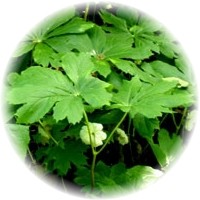
Mayapple is a perennial herb that is normally between one to two feet in height. The plant bears leaves of which one or two open out like an umbrella and has only one white flower that blossoms below the leaves. The plant has a chunky rhizome or tuber that is reddish brown in color. The mayapple plant bears fruits that are small and yellow in color.
100% natural oil to treat effectively skin conditions such as acne, psoriasis, and rosacea.
The mayapple plants are found in abundance in the woodlands and hence the umbrella-like leaves are common in these areas. In fact, the North American Indians were familiar with mayapple plant and appreciated the plant's laxative (substances that promote bowel movements, either by irritating the lower colon or by bulking the stool) properties. They used the herb to cure worms in the intestines, warts (moles) and sometimes also as an insecticide for their crops. It seems that the North American Indians had recognized the herb's toxic or noxious properties. It may be mentioned here that there are reports that some of these Indians even consumed the mayapple with a view to commit suicide.
The North American Indians also ate the mayapple fruits - the lone part of the herb that is not toxic. Incidentally, though it is said to be tasteless, many people eat the mayapple fruits even today. According to a 19th century botanist, mayapple fruits are useless and tasted syrupy something, according to him, was a favorite with small boys, pigs and raccoons (a small animal with grayish black fur, black patches around the eyes, and a long bushy ringed tail usually found in north and central America).
All the strength of pharmaceutical fungicides - but without the harsh chemicals.
Mayapple has a clambering rhizome or tuber that is as thin as a pencil and grows up to six feet. This part of the plant is of medicinal use and is harvested in autumn when the plants die down. Soon after harvesting, the rhizomes are dried and pulverized into fine particles. Despite being used to treat various disorders that range from liver problems to cancer, mayapple is still best known for its advantages as a laxative. However, the Food and Drug Administration (FDA) in the U.S. has listed the use of mayapple as 'unsafe' owing to its potent purgative (a substance used for removal of bowels) measures.
Rhizome.
Mayapple owes its Latin name to the Greek words podos and phyllon denotating foot-shaped leaves. On the other hand, when translated into English, the term peltatum means 'shield-like'. It is important to note here that while the matured mayapple fruit is edible and many even prepare jellies and juices with it, the plant's roots, leaves, seeds as well as the raw fruits are all said to be toxic. Since the adults are always concerned that their children should stay away from the mayapple for its toxicity, the innocent children are made to believe that the plant is looked after by the devil. Earlier, the indigenous Americans used the root, fruit and even the decoction (extracting an important ingredient of a plant by boiling it) of the entire plant to prepared insecticides.
Stop losing your hair with this outstanding, 100% natural formula.
FOR MEN AND WOMEN.
Ancient records show that the American ethnic groups also drank a ferment prepared from the dehydrated and crushed rhizome or tubers of mayapple as a medication to cure worms in the intestines. They also used the substance as a remedy for snakebite as also as a laxative to clear bowel movements. In earlier days, mayapple was used as an ingredient for preparing laxative and sold over the counter as a medicine known as 'Carter's Little Liver Pills". Presently, herbal practitioners use extracts from the mayapple plant on the surface to cure genital warts or moles and also sometimes to combat skin cancers. According to researches, podophyllotoxin, a fatal ingredient of the herb, stops cell division and also possesses features that are able to restrain tumors. Significantly, the FDA in the United States has approved two drugs - etoposide and teniposide - prepared from podophyllotoxin for use in the country. While etoposide is administered to cure testicular and small-cell lung cancer, teniposide is used in conditions like brain tumor and infancy leukemia. However, the FDA has banned the use of the substance as a laxative keeping in view the herb's toxic nature.
Notwithstanding the confidence of the people regarding the safety in using the mayapple in the 19th century, the drug is no more taken internally owing to its cytotoxic or action or ability to kill cells. Nevertheless, the root can be beneficial in treating all types of moles, if poultices, cream or ointment prepared from it is applied externally.
The mayapple plant is native to the eastern regions of the United States and parts of southern Canada. The American mayapple normally grows on small patches of land or plots.
Over the years, scientists have conducted extensive research on the lignans (a phenol amalgam mainly present in plants and are through to safeguard human beings from tumors and viruses) present in mayapple. The researches have found that especially podophyllotoxin is effective in combating tumors. Now scientists are researching to discover the anti-cancer potential of podophyllotoxin. It is believed that semi-artificial or synthetic podophyllotoxin derivates have the maximum potential in combating cancer and they are also said to have the smallest amount of toxicants.
The rhizome of mayapple contains lignans (especially podophyllotoxin), flavonoids, resin, and gums. The lignans are responsible for the rhizome's purgative action.